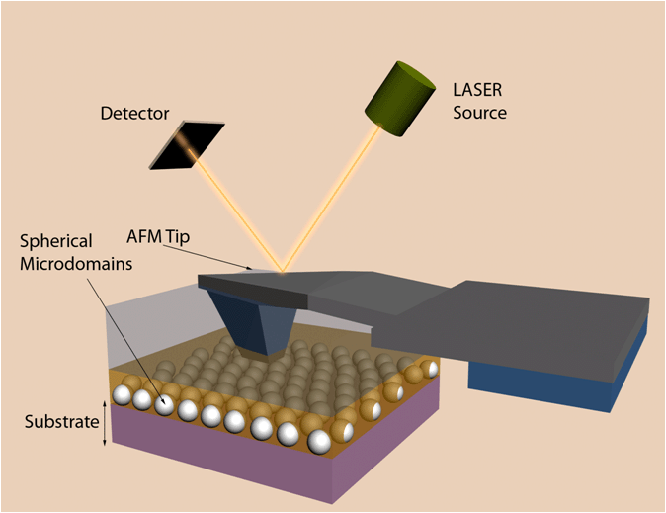

46380-GB7
Nanometer-Scale Shearing and Curvature-Driven Grain Boundary Migration in Diblock Copolymer Thin Films
Asymmetric diblock copolymer materials are known to self assemble into spherical microdomains, with spheres composed of the copolymer’s minority block formed within a matrix of the majority block. In a thin film, these microdomains spontaneously arrange themselves into a locally well-ordered hexagonal lattice; local orientation extends over regions, or “grains,” with well defined boundaries. Above the copolymer’s glass temperature, diffusion of molecules can lead to migration of microdomains and of grain boundaries. The goal of this project is to measure grain boundary velocities as a function of their curvature to better understand the dynamics of these systems.
We noticed, however, that the high viscosity of the
silicone oil significantly slows the response of the cantilever to interactions
with the sample surface; as the cantilever approaches the copolymer surface,
the time for the cantilever to be pulled down to the surface is slowed to about
5 msec. We are currently optimistic
that the length of this response time may allow us to engineer an active
control system that will keep the AFM tip suspended just a few nanometers above
the sample surface. Our present
strategy is to modulate the tip’s height, periodically approaching the
surface but then pulling back fast enough to avoid actually contact with
it. By monitoring the tip
deflection in response to this modulation and using it as the control for a closed-loop
feedback system, we hope to maintain an average tip height of a few nanometers
above the sample surface. Our work
in this area continues. Other work in support of this project continues as
well. We have designed and built a
flow coater in our laboratory, used to produce thin polymer films for this
study, based on a prototype developed at the National Institute of Standards
and Technology (NIST). The flow
coater works by using a blade suspended over a substrate to draw a polymer
solution across its surface at a well-defined speed. Shear alignment is especially sensitive
to film thickness; the advantage of using flow coating instead of standard spin
coating is that we can make a sample with a thickness gradient, guaranteeing
that at least some area of a sample will be of a thickness appropriate for good
alignment. We have successfully
developed improved control software for the flow coater which allows us to coat
a surface with a truly linear thickness gradient, an improvement over the
original design from NIST. Work of
a recent undergraduate student has also added a simple laser interferometry
device to more precisely monitor the height of the blade over the sample
substrate. Critical
to this project is the ability to perform accurate metrology of polymer-coated
surfaces by AFM imaging. A major
obstacle to this has been thermal drift in the AFM, which causes significant
image distortion. We have
significantly improved our technique for correcting this distortion using
post-processing software. The
result of our work in this area is a fully automated, software-based
method for removing nonlinear (up to third order) drift in two dimensions from
a single AFM image, using only a small rescan area as a reference. Our method requires minimal computation
time, is broadly applicable to a variety of images and is demonstrated to be
extremely robust to both periodicity and imaging artifacts. We have recently submitted this work to
a leading microscopy journal, and are currently awaiting referee reports. We look forward to sharing our results
and making our software available to the broader
imaging community. Finally, we have expanded the scope our work to consider
the fundamental phase behavior of block copolymer materials on substrates in
the presence of step edges. It is
well known that diblock copolymer films with thicknesses incommensurate with
the lattice spacing spontaneously form a series of mesas and valleys of
commensurate thicknesses. We have
used our new flow-coating capability to produce films with thickness gradient
on substrates with step edges of varying heights, to perform a multidimensional
combinatorial study of these two variables on film morphology. We have also examined the effects of
substrate step edges on microdomain alignment. We look forward to submitting a
manuscript based on this work for publication later this year.
 Our experiment consists of preparing films with
specifically tailored, long and narrow grains, and observing their subsequent
evolution through atomic force microscopy (AFM). Grains will be created by selectively
aligning the spherical microdomains in a small area of a film using a shear
stress applied by a flattened cantilever tip on an AFM. Our strategy has been to avoid
potentially damaging capillary forces between the AFM tip and the molten copolymer
sample by performing the alignment in a fluid cell filled with a silicone oil
that preferentially wets the tip.
Our initial attempts were not been successful, as the tip still appears
prone to being wicked down into the polymer layer.
Our experiment consists of preparing films with
specifically tailored, long and narrow grains, and observing their subsequent
evolution through atomic force microscopy (AFM). Grains will be created by selectively
aligning the spherical microdomains in a small area of a film using a shear
stress applied by a flattened cantilever tip on an AFM. Our strategy has been to avoid
potentially damaging capillary forces between the AFM tip and the molten copolymer
sample by performing the alignment in a fluid cell filled with a silicone oil
that preferentially wets the tip.
Our initial attempts were not been successful, as the tip still appears
prone to being wicked down into the polymer layer.